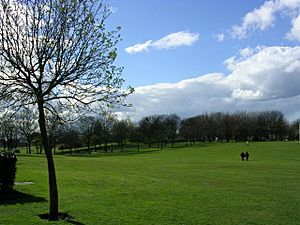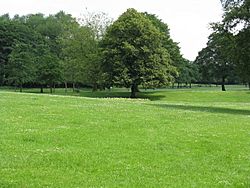Buile Hill Park facts for kids
Quick facts for kids Buile Hill Park |
|
|---|---|
 |
|
| Location | Salford, Greater Manchester |
| Area | 35 hectares |
| Created | 1902, expanded in 1903 to incorporate Seedley Park |
| Designation | Grade II |
Buile Hill Park is a very special public park and a large house in Salford, Greater Manchester, England. It's listed as a Grade II building, which means it's an important historical place.
This park is huge, covering about 35 hectares (that's like 86 football fields!). It's the biggest public park in Salford and the second oldest, after Peel Park. The park and its mansion are owned by Salford City Council. The mansion house is currently empty, but there are plans to bring it back to life. A group called the Friends of Buile Hill Park helps look after the park and its activities.
Contents
A Look Back: The Park's Story
Buile Hill Park has a long and interesting history!
From Private Home to Public Park
Long ago, in 1590, a part of the land where the park now stands was used to bury people who had suffered from the plague.
Much later, in 1825, a man named Thomas Potter decided to build a grand mansion here. He asked a famous architect, Sir Charles Barry, to design it. The house was finished in 1827. Thomas Potter became the very first Mayor of Manchester in 1838! He was even knighted, becoming Sir Thomas Potter. After he passed away, his wife, Lady Esther Potter, continued to live in the mansion.
In 1877, the Potter family sold Buile Hill to John Marsland Bennet, who was also a Mayor of Manchester.
The most exciting change happened in 1902. Salford Council bought the estate to turn it into a public park for everyone to enjoy. They spent money to get it ready, and local people even helped by donating money. Buile Hill Park officially opened on July 22, 1903. It was later connected to another park, Seedley Park, making it even bigger!
Wartime Role and New Features
Over the years, the park added many fun things. In 1906, the old mansion became a natural history museum, showing off cool plants and animals. That same year, tennis courts opened. Later, in 1934, an 18-hole pitch and putt golf course was added. A cafe opened in 1938, inside what used to be the mansion's conservatory.
During both World War I and World War II, Buile Hill Park played an important role. In the First World War, it had a special gun to shoot down Zeppelin airships. In the Second World War, it was home to a barrage balloon attachment, which helped protect the area from enemy planes. Because of this, a German bomb was even dropped on the park in 1940!
After the wars, the park was fixed up and reopened in 1948. More new features arrived: a special garden for the blind opened in 1963, and a "Pets Corner" for animals opened in 1972.
Famous Visitors and the Mansion's Future
Many interesting people have visited Buile Hill Park. The famous artist L.S. Lowry, who painted scenes of everyday life in Salford, often came here. Also, the author Frances Hodgson Burnett is said to have written parts of her classic children's book, The Secret Garden, during her visits to the mansion!
In 1975, the mansion became the Lancashire Museum of Mining, teaching people about local coal mining. However, it closed in 2000 and has been empty ever since. There have been different ideas to turn it into a hotel or a meeting place, but so far, nothing has worked out.
In 2016, an old, empty building in the park caught fire.
Today, the Friends of Buile Hill Park and the local council are working hard to find a new purpose for the mansion and keep the park a wonderful place for everyone.


